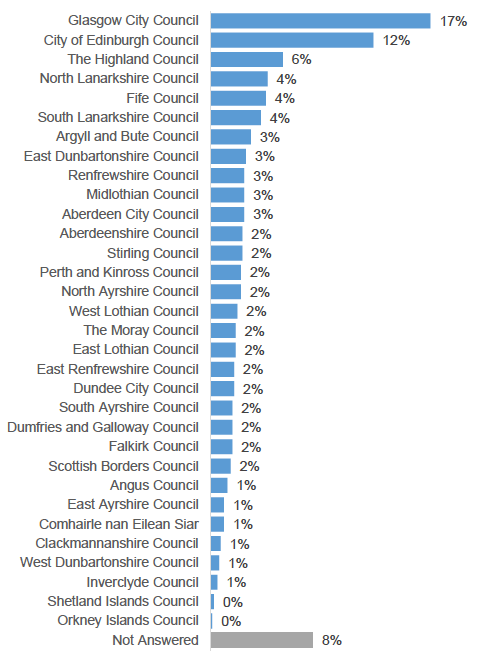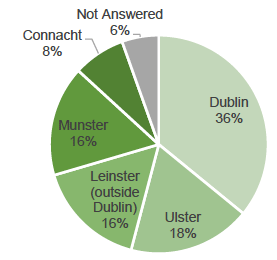Joint bilateral review of the relationship between Scotland and Ireland - public engagement: analytical summary
This is a report of the public engagement exercise conducted as part of the Ireland-Scotland joint bilateral review.
2. The online questionnaire – results
As part of the joint bilateral review of the Scotland-Ireland relationship, the questionnaire was intended to gather views from those with an interest in how Ireland and Scotland associate, cooperate, and collaborate as close neighbours, now and in the next five years.
The questionnaire was one part of a broader engagement exercise being conducted by the Scottish Government and the Government of Ireland to draw in a rich variety of experiences, views and ideas. This analysis of the questionnaire has informed the report of the Ireland-Scotland joint bilateral review which focusses on five thematic areas[2]:
- Business and economic interests
- Community and diaspora links
- Culture experience and exchange
- Rural, coastal and island communities
- Academic, educational and research links
The questionnaire collected basic information about the respondent (see Annex A), and asked a range of questions on the respondents’ views of the Scottish-Irish relationship and then welcomed contributions on the review themes.
2.1 About the analysis – methodological approach
This online engagement of the Ireland-Scotland joint bilateral review was run on Delib’s Citizen Space, the Scottish Government's digital platform for consultations to enable people to submit their response online. Citizen Space is managed by the Scottish Government’s Digital Engagement Team, and the analysis of the data was conducted by Scottish Government social researchers who consulted with Department of Foreign Affairs officials, compliant with the data sharing agreement above.
The questionnaire included both quantitative and qualitative questions (see Annex A). Some contributions submitted via email, which followed the structure of the questionnaire, were also included in this analysis.
The methodological approach taken in analysing the responses is fourfold:
1. All responses were screened for offensive content, for example if they used inappropriate, defamatory or offensive language. These responses were either redacted or omitted if the entire response was offensive.
2. All closed questions were analysed using descriptive quantitative cross-tabs illustrating frequencies of responses. Responses were grouped according to where respondents are based.
3. All open questions were read, summarised and coded. These codes or key words were then aggregated into sub-themes that are nested within the five main themes of the engagement. These sub-themes enabled the analysts to structure and summarise the responses to illustrate the breadth and range of responses. Frequency of responses were indicated either by specifying the number of responses that relate to the sub-theme or by providing an estimate, such as ‘a few’ or ‘many’.
4. Responses submitted directly via email were recorded, summarised, and content allocated to the sub-themes and incorporated into the analysis.
2.2 About the respondents and responses
This section describes the type of responses and provides details on the respondents. It illustrates the number of valid responses and outlines why few responses were omitted from the analysis.
The questionnaire opened on 23 December 2019 on Citizen Space and closed 12 weeks later on 20 March 2020. Respondents were asked to indicate whether they were based in Scotland, Ireland or elsewhere at the time of their return. Respondents based in Scotland were invited to provide details of their location by local council area. For those based in Ireland, respondents could provide details of their location and had the option of selecting Connacht, Leinster (outside Dublin), Dublin, Munster, or Ulster. All respondents who indicated that they were based neither in Ireland nor Scotland (or who did not provide a location) answered a common questionnaire for those “elsewhere in the world.”
During this period, 1,068 responses were received, with nearly three in four based in Scotland (73%), 21% based in Ireland and 7% from elsewhere (see Table 1 below).
| Respondents | n | % |
|---|---|---|
| Based in Ireland | 219 | 20.5% |
| Based in Scotland | 779 | 72.9% |
| Based elsewhere, or not known | 70 | 6.6% |
| Total | 1068 | 100.0% |
Respondents provided details on the specific region they or their organisation are based. Figure 2 below illustrates that for the responses based in Scotland, most stem from Scotland’s two largest cities. Seventeen percent of these responses are from Glasgow (17%), followed by 12% from Edinburgh. Whilst more responses were submitted from the local authorities on the west coast – such as the Highland Council, North and South Lanarkshire and Argyll and Bute – local authorities on the east coast, such as Fife and Midlothian, are also represented. The islands are not particularly well represented with one response received from Orkney, two from Shetland and eight from Na h-Eileanan Siar.

Figure 3 illustrates the regional profile of responses based in Ireland by province, with Leinster divided into ‘Dublin’ and ‘rest of Leinster’. The largest proportion of responses were from Dublin with 36%. Respondents based in Ulster provided the next largest share (18%), followed by Leinster (outside Dublin) (16%) and Munster (16%). Eight percent of respondents based in Ireland indicated they were in Connacht. Respondents were also asked if they had recently been in contact with the Consulate General of Ireland in Edinburgh or with the Scottish Government Office in Dublin. Of those 218 respondents based in Ireland, 18 had recently been in touch with the Consulate General of Ireland in Edinburgh, compared to 12 of those based in Scotland and two based elsewhere. The number of respondents who had been in touch with the Scottish Government Office in Dublin is slightly higher, which also reflects the overall higher number of respondents based in Scotland: 89 of 774 respondents based in Scotland had been in contact, with 11 of those based in Ireland and three of those based elsewhere.

Of all 1,068 responses, six were omitted from the analysis due to offensive language, two of which were organisational responses and four individual ones. Thus, 1,024 valid individual responses (96%) were considered and 38 (4%) organisational ones.
Respondents were informed that their responses would be summarised, but not published in full. Furthermore, 79% were content to be contacted in the future in relation to the joint bilateral review, 21% were not.
As outlined above, 1,068 responses were submitted to the online questionnaire via Citizen Space. An additional 17 contributions were submitted via email to the Government of Ireland and Scottish Government, either directly or sent to an email account that had been set up specifically for the purpose of this review. Of these 17 email contributions, 12 were confirmed to be organisational responses. These email contributions are included in the analysis in Chapter 4. Wherever necessary, joint submissions were highlighted. All organisations that responded to this review, either via email or Citizen Space, are listed in Annex B.
Chapter 3 summarises all responses to the closed questions. This analysis is quantitative. However, it does not represent the views of the wider public and solely reflects the opinions of the respondents to this engagement. Chapter 4 provides an overview of the range and depth of all comments submitted to the open questions, specifically focusing on contributions to the five key themes of this engagement. As explained in section 2.1, these themes are divided into sub-themes to illustrate the areas of interest that emerged from the submissions. This analytical report aims to summarise these contributions and it needs to be highlighted that it is not the purpose of this report to review or reflect on the accuracy or feasibility of any suggestions made.
Contact
Email: socialresearch@gov.scot
There is a problem
Thanks for your feedback